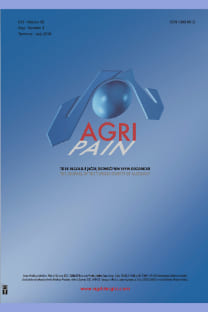Miyomektomi sonrası lornoksikamın postoperatif ağrı üzerine etkisi
Analjezi, epidural, Analjezi, hasta kontrollü, Ağrı ölçümü, Ağrı, ameliyat sonrası, Anti-enflamatuvar ajanlar, steroid olmayan, Jinekolojik cerrahi prosedürler, Morfin
Effect of lornoxicam on postoperative analgesia after myomectomy
Analgesia, Epidural, Analgesia, Patient-Controlled, Pain Measurement, Pain, Postoperative, Anti-Inflammatory Agents, Non-Steroidal, Gynecologic Surgical Procedures, Morphine,
___
- Akın A, Esmaoğlu A, Boyacı A. Total kalça protezi uygulanan hastalarda piroksikamın preemptif analjezik etkinliği. Türk Anest Rean Cem Mecmuası. 2002;30:161-5.
- Arslan M, Tuncer B, Babacan A, Taneri F, Karadenizli Y, Onuk E, et al: Postoperative analgesic effects of lornoxicam after thyroidectomy: a placebo controlled randomized study. Agri. 2006;18:27-33.
- Benzon HT, Wong HY, Belavic AM Jr,Goodman I, Mitchell D,Lefheit T, et al. A randomized double-blind comparison of epidural fentanyl infusion versus patient controlled analgesia with morphine for post thoracotomy pain.Anesth Analg. 1993;76:316-22.
- Blaicher AM, Landsteiner HT, Zwerina J, Leitgeb U, Volf I,Hoerauf K. Effect of non-selective,nonsteroidal antiinf lammatory drugs and cyclo-oxygenase 2 selective inhibitors on the PFA-100 closure time. Anaesthesia 2004; 59: 1100-3.
- Cavaliere F, Antonelli M, Arcangeli A, Conti G, Costa R,Pennisi MA, et al. A low dose remifentanil infusion is well tolerated for sedation in mechanically ventilated, critically ill patients. Can J Anaesth. 2002;49:1088-94
- Detlet E, Albrechtsen M, Stolke D. A comparison of patientcontrolled analgesia with lornoxicam versus morphine in patients undergoing lumbar disk surgery. Anesth Analg. 1998;86:1045-50.
- Dionne RA, Campbell RA, Cooper SA, Hall DL, Buckingham B.Supression of post operative pain by preoperative administration of ibuprofen in comparison to placebo, acetaminophen and acetaminophen plus codeine. J Clin Pharmacol. 1983;23:37-43.
- Erdine S. Ameliyat sonrasi agri tedavisi. Ağrı Sendromları ve tedavisi, Gizben Matbaacılık, 2nd Edn. Istanbul: 2003:43.
- Gong ZY, Ye TH, Qin XT, Yu GX, Guo XY, Luo AL. Patientcontrolled analgesia with lornoxicam in patients under going gynecological surgery. Zhongguo Yi Xue Ke Xue Yuan Xue Bao. 2001;23:472-5.
- Huang JJ, Taguchi A, Hsu H, Andriole GL Jr, Kurz A. A preoperative oral rofecoxib does not decrease postoperative pain after radical prostatectomy. A prospective, randomize, double-blinded, placebo-controlled trial. J Clin Anesth. 2001;13:94-7.
- Ilias W, Jansen M. Pain control after hysteroctomy: An observer-blind, randomised trial of lornoxicam versus tramadol. Br J Clin Pract. 1996;50:197-202.
- Karaman S, Gunusen I, Uyar M, Firat V: The effect of preoperative lornoxicam and ketoprofen application on the morphine consumption of postoperative patient controll ed analgesia. J Int Med Res. 2006;34:168-175.
- Macintyre PE. Safety and efficacy of patient-controlled analgesia. Br J Anaesth. 2001; 87:36-46.
- Malan TP, Marsh G, Hakki SI, Grossman E, Traylor L, Hubbard RC. Parecoxib sodium, a parenteral cyclooxygenase 2 selective inhibitor, improves morphine analgesia and is opioid sparing following total hip arthroplasty. Anesthesiology 2003; 98: 950-6.
- Mitchell RW, Smith G. The control of acute post-operative pain. Br J Anaesth.1989;63: 147-158.
- Ng A, Smith G, Davidson AC. Analgesic effects of parecoxib following total abdominal hysterectomy. Br J Anaesth. 2003;90:746-9.
- Owen H, Glavin RJ, Shaw NA. Ibuprofen in the management of post operative pain. Br J Anaesth. 1986;58:1371-5.
- Papadima A, Lagoudionakis EE, Antonakis PT, Pattas M,Kremastinou F, Katergiannakis V, et al. Parecoxib vs lornoxicam in the treatment of postoperative pain after laparoscopic cholecystectomy: a prospective randomized placebo-controlled trial. Eur J Anaesthesiol.2007;24:154-8.
- Radhofer-Welte S, Rabasseda X. Lornoxicam, a new potent NSA ID with an improved tolerability profile. Drugs Today. 2000;36:55-76.
- Rogers JE, Fleming BG, Macintosh KC, Johnston B, Morgan- Hughes JO. Effect of timing of ketorolac administration on patient-controlled opioid use. Br J Anaesth. 1995;75: 15-8.
- Schafer AI. Effects of nonsteroidal antiinflammatory drugs on platelet function and systemic hemostasis. J Clin Pharmacol. 1995;35:209-19
- Serpell MG, Thomson MF:.Comparison of Piroxicam with placebo in the management of pain after total hip replacement. Br J Anaesth. 1989;63:354-6.
- Sinatra RS. Acute pain management and acute pain services. In:Cousins MJ, Bridenbaugh PO, editors. Neural blockade: In clinical anesthesia and management of pain. Philadelphia: Lippincott- Raven; 1998. p. 793-835.
- Staunstrup H, Ovesen J, Larsen UT, Elbaek K, LarsenU, Kroner K. Efficacy and tolerability of lornoxicam in postoperative pain. J Clin Pharmacol. 1999;39:834 – 41.
- Sunshine A, Roure C, Colon A, Olson NZ, Gonzalez L, Siegel C,et al. Analgesic efficacy of piroxicam in the treatment postoperative pain. Am J Med. 1988;84:16 – 22.
- Thompson JP, Sharpe P, Kiani S, Owen-Smith O. Effect of meloxicam on postoperative pain after abdominal hysterectomy. Br J Anaesth. 2000;84:151-4.
- Tramer MR. Efficacy and advers effect of prophylactic antiemetics during patient-controlled analgesia therapy:a quantitative systematic review. Anesth Analg. 1999;88:1354-61
- Tramer MR. A rational approach to the control of postoperative nausea and vomiting evidence from systematic reviews. Part I. Efficacy and horn of antiemetic interventions and some methodological issues. Acta Anaesthesiol Scand.2001;45:4-13.
- Trampitsch E, Pipam W, Moertl M, Sadjak A, Dorn C, Sittl R, et al. Preemptive randomized, double-blind study with lornoxicam in gynecological surgery. Schmerz. 2003;17:4-10.
- ISSN: 1300-0012
- Yayın Aralığı: Yılda 4 Sayı
- Başlangıç: 2018
- Yayıncı: Ali Cangül
Migren baş ağrısında büyük oksipital sinir bloğu: 10 hastanın ön sonuçları
SUNA AKIN TAKMAZ, NURTEN İNAN, Serap ÜÇLER, Mehmet Akif YAZAR, Levent İNAN, Hülya BAŞAR
Nöropatik ağrı açısından fibromyalji sendromu
Yetişkin travma hastalarında ağrı şiddeti ve analjezi yaklaşımları
Fatma Eti ASLAN, Dilek SARIYILDIZ, AYSEL GÜRKAN, Dilek AYGİN
Hemiplejik omuz ağrısında TENS tedavisinin etkileri: Plasebo kontrollü bir çalışma
Ayşe EKİM, Onur ARMAĞAN, Cengiz ÖNER
Sibel EYİGÖR, Hale KARAPOLAT, Uğur İBİŞOĞLU, BERRİN DURMAZ
Total kalça protezinde preoperatif 3-1 bloğun postoperatif ağrı ve tramadol tüketimi üzerine etkisi
Süleyman KÖROĞLU, SUNA AKIN TAKMAZ, ÇETİN KAYMAK, Altuğ NARLI, Kubilay KALEZLİ, Beyazıt DİKMEN
Miyomektomi sonrası lornoksikamın postoperatif ağrı üzerine etkisi
İpek ERDOĞAN, Türkay ÇAKAN, Ayşe ÖZCAN, Esra TÜRKYILMAZ, Bülent BALTACI, Bayazıt DİKMEN
